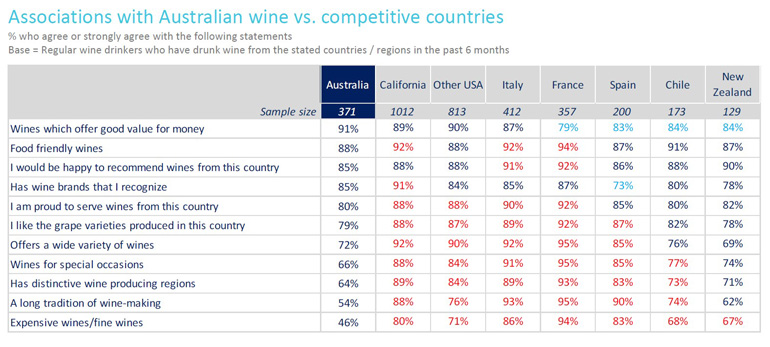What is driving grape prices in Australia’s warmer inland regions?
Market Bulletin | Issue 88
Australia’s three warmer inland regions of the Riverland, Murray Darling–Swan Hill and Riverina are the engine room of the Australian grape and wine community’s production volumes.
Combined, the regions account for around 40 per cent of Australia’s winegrape vineyard area and more than 70 per cent of the national winegrape crush. The grapes from these regions produce some of Australia’s biggest selling wine brands both domestically and in overseas markets. They are also the cornerstone of the Australia’s commodity and bulk wine trade.
The global impact on local grape prices
At least two-thirds of wine produced from the warmer inland regions is exported. As a result, the global wine supply and demand situation is a major determinant of wine grape pricing in the warmer inland regions. At 790 million litres, Australia is a relatively small producer in comparison to the major producers of France, Italy, Spain, and, to a lesser degree, the United States. The supply situation in these countries has a significant impact on Australia’s trade, particularly at the price-driven commodity end of the market.
The biggest influence on bulk wine prices over the last few years was the huge crop Spain produced in 2013. According to the OIV, Spanish wine production increased by 44 per cent to 4.6 billion litres in 2013. Such a large volume of wine had a deflationary effect on prices for commodity wine, not just for Spain but for other producers such as Australia. In 2015–16, Spain exported 1.3 billion litres of bulk wine at US$0.41 per litre – this is more than Australia’s total wine production and it was exported at around half the average bulk wine price of Australian wine.
Demand for Australian wine provides positive potential
However, the global supply and demand situation is changing quickly. There is strong demand for Australian wine stemming from China and Asia in general as well as the United States. Furthermore, as the pound appreciates, margins in the United Kingdom may improve.
While China is the largest and fastest growing market for Australia’s premium wines, there has also been an increase in exports of commercial wines. This is the market segment that the warmer inland regions predominantly supply. This increase reflects a broadening of the base of Chinese wine consumers. More Chinese can now afford to buy imported wines and are moving from domestic to commercial imported wines. There has also been a shift from gift-giving to personal, everyday consumption.
2017 vintage proved mixed price figures
While global demand for wine is growing, historically low vintages in France, Italy and Spain in 2017 and another small vintage in Chile will see global production fall to the lowest level since 1961. This may result in further upward pressure on bulk wine prices and grape prices.
The 2017 vintage saw mixed results in the three regions for Australia’s three major varieties (see table below). All three varieties recorded increased average prices in the Riverland and Murray Darling–Swan Hill but only Chardonnay increased in Riverina. Indicative prices for 2018 Riverland fruit are up on 2017, with demand for Shiraz and Cabernet Sauvignon somewhat stronger than for Chardonnay.
Average purchase prices in 2017
|
|
Shiraz |
Cabernet Sauvignon |
Chardonnay |
|||
|
$/t |
Change |
$/t |
Change |
$/t |
Change |
|
|
Riverland |
396 |
18% |
391 |
13% |
310 |
6% |
|
Riverina |
344 |
-3% |
366 |
-1% |
321 |
13% |
|
Murray Darling–Swan Hill |
395 |
23% |
403 |
22% |
310 |
10% |
What’s in a name?
One factor that may be impede sustained higher prices in the warmer inland is that much of the wine exported from the warmer inland is labelled as being sourced from the South Eastern Australia Geographical Indication (SEA GI), a fairly generic term that fails to differentiate between the three regions.
To illustrate, 777 million litres of Australian wine was exported in 2016–17 with 519 million litres of this identified as wine that was sourced from the SEA GI. In comparison, exports specifically identifying the Riverland GI totalled 47 million litres, with another 47 million litres from Murray Darling–Swan Hill and 18 million litres from Riverina.
Arguably, using the SEA GI label has contributed to the commodisation of wines from the warmer inland regions and has made it difficult for growers to achieve consistently higher grape prices. Essentially commodisation is competition to lower prices for a standard level of quality. It is the opposite of premiumisation.
For the warmer inland regions to take advantage of the global premiumisation trend, one possible option is to encourage wineries to cease using the SEA GI label. It is not mandatory to use this label. Exports identifying the individual warmer inland regions achieve a higher average price than exports of SEA labelled wines (see chart below). This may indicate that there is some cache in using the individual region GIs rather than the SEA GI.
Average dollars per litre of bottled exports by GI label, 2016–17

There is a strong correlation between export prices and grape purchase prices. If the warmer inland regions can lift the price of the wines exported from the region then this is likely to flow through to the prices paid for their grapes.
Export prices v grape purchase prices over time

There can be no doubting the consistency of quality of wines from the warmer inland regions and this clearly resonates with wine consumers. For example, research conducted in the United States by Wine Intelligence on behalf of Wine Australia shows that Australian wine leads all key competitors in being viewed as value for money (see below). However, we do trail perceptions as an expensive/fine wine.
